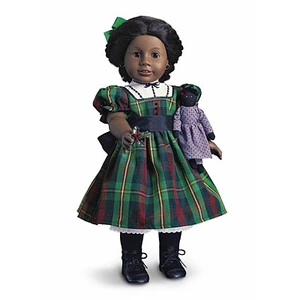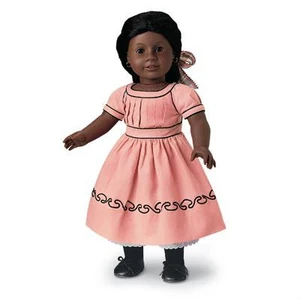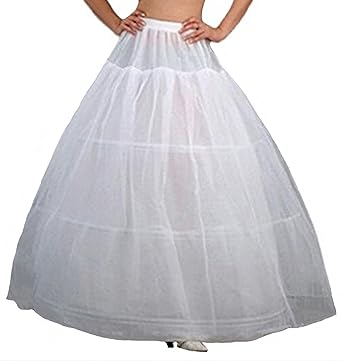Now, before you get mad at me for clumping the two together, AG practically did the same thing by changing Cécile's crinoline and chemise to being Addy's crinoline and chemise without even changing its appearance. They also gave the lacy parasol Cécile had to Samantha... So if a big corporation can do it and get away with it, why can't I? (That's what we all think, right?) Most of the information you can find on the internet does not give exact years for certain fashions coming into vogue (fashion is kind of pinpoint by date, especially when looking at it historically). Also, I know I will come under fire for the people who all clamor and foam at the mouth at an ex-slave girl like Addy getting to wear 'clothes that are too pretty for her'... I don't see any of the fashions that Addy as had as something she wouldn't wear back then. I imagine her mother, who works as a seamstress, may use some fabric left over from her wealthy patrons who ordered too much to make clothes for her child. A seamstress has to make good, expensive clothes, especially back then, so it's not impossible for Addy to get some pretty dresses. If anyone who doesn't deserve to have fancy clothes, it's Kit because she's from the 1930s and people had a hard time trying to get food let alone get nice clothes but look at her...
Anyways, onto the fashions! This is more of a guide as to what to sew in one nice blog post. Instead of being based on fantasy, I will try to help you make your clothes historically accurate (though
some fantasy is fine!). Rich people's clothes will be the ones most talked about. If your doll is 'poorer' than the upper class, just follow the trends but tone down the fabric and elegance a little. Even nowadays, you can see it even in the most 'common' of things - makeup. Anything you can dream of getting in a high-end store like Sephora you can find much cheaper in CVS' makeup aisle. It all depends on your ability to find a good deal and making the most out of what you
do have. Children of both eras often were just dressed like miniature adults so most of the illustrations will be of adults.
Most portraits and illustrations were of white people, so I apologize in advance for that.
The 1850s (Cécile)
A new type of outfit, called either the "Turkish costume" or "bloomers" (presumably after the publisher of a paper about it named Amelia Bloomer) [
1] appeared briefly in 1851. It was thought too unbecoming for an American audience and so it was abandoned by most. The outfit was simple -loose trousers gathered at the ankles and topped off with a simple short skirt or dress [
2]. This was the first attempt to make a clothing reform to change the uncomfortable, impractical clothes of the time to something simpler for women to wear. It was a type of feminism aimed to try and make women as comfortable as men [
2]. If you were a feminist back in the 1850s and didn't care what others said about it, you may have tried this outfit out.
In the early 1850s, day dresses (yes, you had a different dress for each part of the day as a woman) sported wide collars made of lace, crochet or tatting [
1]. The front of the waist was accented by a shallow and rounded dip from the bodice to the skirt [
1]. Ginghams, calicos, checks, and plaids were all common patterns for the day dress [
1].
 |
| 1851 Journal des Demoisselles, day dresses (source) |
 |
| 1851 - 1854 Two-piece day dress [source] |
In the later 1850s, bishop sleeves (full, long sleeves that end in cuffs at the wrist) and a long, plain bodice that opened in the front [
1].
 |
| Bishop sleeves: American Girl Version |
The final transition that marked the end of the 1840s for good and began to establish the 1850s as its own fashion period is the change of the corset [
1]. Yes, the fashionable woman would toss out her older shaped corset in favor of the newest trend. The long, bust flattening corset fell out of favor and was replaced by a flaring form that allowed the bosom to be less restrained around the year of 1853 [
1].
The basque waist (hip length jacket that was tight fitting over the bosom and waist with a flare over the hips and flaring sleeves) were popular in the 1850s and often had beautiful decorations (buttons, ribbons, etc) on them [
1].
 |
| Dress in basque styling and bishop sleeves - the fabric under the sleeves was to make sure that none of that 'naughty' arm flesh showed [source] |
The final and biggest addition the 1850s brought to fashion was the hoop skirt [
1]. The hoop is basically a metal cage put around your waist to puff your skirt out. This fashion began in 1856 [
1]. Crinoline was also invented to suit this fashion so you would no longer have to haul around a bunch of petticoats under your skirt [
3].
Evening dresses, like the ones that Cécile and Marie-Grace would have worn at the children's ball (albeit probably not a smaller scale because they are indeed still girls and not fully 'women' yet), were at their heights in the 1850s. At least a 1850s evening dress is what my mind immediately goes to when I think of a ball. The hoop skirt allowed skirts to be full and round. The later 1850s and early 1860s have a lot of similarities when it comes to the silhouette of the evening gown but there are subtle differences [
3].
The late 1850s had many elegant frills added to both the skirt and sleeves while the 1860s saw these things get toned down [
3]. The little things, like decorations on the neckline, were also elaborate like lace, flower bouquets (or single flowers, roses were popular), and jewels [
3]. Asymmetrical flower bouquets were placed on skirts [
3].
The neckline, unlike the day dress, was open, allowing the shoulders to be bare (which will always remind me of that one scene in Gone With The Wind where Mammy is scolding Scarlett for showing off her bosom before 3 o'clock) [
3]. Sleeves were short and puffed and came in a wide variety of styles (mainly petal, puff, cap and bell - they seemed to be the most popular because they were combined together at times) [
3].
The color of the dress depended on your age: if you were a young girl (like Cécile) you would wear pastel and light color dresses (often white) while older women wore richer and darker colors [
3]. Plain and dotted silk were popular, along with taffeta, moire, organdie, muslin, tulle and lightweight brocade [
3].
The 1860s (Addy)
Of course, before I can begin on what Addy would have worn after she got her freedom, I will have to discuss what she would have worn as a slave.
Slaves were not given a lot of clothing [
4], obviously. The amount of clothing given varied from plantation to plantation but the common amounts and types of clothes given were: 2 suits, 1 pair of shoes and 1 blanket [
4]. Usually, clothes were given out twice a year [
4]. At some plantations, children stayed naked until they were 10 to 12 years old [
4]. Sometimes plain leather hats and shoes were given [
4]. The material used to make clothing was cheap (and thus the fabric was coarse and thin) and shoes lasted only a couple of weeks [
4]. If slaves were expected to wash their own clothes and keep them clean, they had to rely on a stream [
4]. Some slaves just wore their clothes until they wore off [
4]. Some plantations allowed their slaves to make baskets and brooms to sell so that they could afford to buy Sunday suits, mittens, and stockings that their owners did not give them [
4]. Women still wore the head wraps and scarves from their native Africa [
4].
The difference between the rich, (mostly) white people's clothes and the enslaved African people's clothes are like night and day.
The early 1860s saw the rise of the gored skirt, which had many bolts of fabric sewn together to make up a full skirt [
5].
 |
| Modern re-creation of a gored skirt from this period [source] |
 |
| The meeting points of the skirt point to it being a gored skirt [source] |
In the mid-1860s, the oval hooped skirt came into vogue. The skirt became more oval shaped - narrow in the front but fuller in the back [
5]. It was because of the gored skirt and a hoop that this look was achieved [
5]. It looks similar to a dress with a bustle, which was common later on in the 19th century.
 |
| A close look at how the oval hooped skirt flows out [source] |
 |
| Oval hooped skirt dress [source] |
Since walking was hard to do with such a long skirt, 1865 saw the introduction of cords being tied onto gowns at certain points to keep the skirt from getting dirty [
5]. (I mean, imagine having to wash those skirts... some of them were made of more than 4 panels of fabric... I wouldn't want that chore...)
The jockey waist gained popularity during this decade. The jockey waist is where two lines, made of either matching fabric or a darker color like black, extend from the bodice and onto the waist [
5]. This fashion trend help led to another fashion trend of pretending to have a high, small waist by accentuating it [
5].
 |
| Portrait of an unidentified woman wearing the jockey styled waist [source] |
As you all may have noticed if you looked at the bodices of this time period closely, almost all bodices were buttoned up in the front [
5] (versus the corset which gets laced up in the back and is worn as underclothes - I know the difference from personal experience. This doesn't mean they stopped wearing corsets, they still did but it was under the clothes). A collar was quite popular for a woman to wear with brooches on top of them [
5]. Both started out small, but as the years went on, they got bigger and more ostentatious [
5].
 |
| Circa 1860s dress with a bow at the top of the row of buttons [source] |
 |
| Late 1860's dress - note how attention is drawn to the buttons through the appliques [source] |
False yokes (fitted shoulder portions that are cut above the bosom) [
5] also came into vogue during this era. Pleats and ruffles often accompanied the false yoke [
5].
 |
| False yoke - American Girl version (the yoke is the white part) [source] |
 |
| A civil war era gown with a false yoke [source] |
The Garibaldi (or Italian) style shirt became popular during this time along with the shirt and waist style, where a woman would wear fuller, separate shirtwaists (usually a plain color) to coordinate with their skirt [
5].
 |
| With a shirtwaist, note how the colors of the waist and shirt match the skirt. [source] |
 |
| Garibaldi blouse in all its glory [source] |
The bishop sleeves of the 1850s remained popular during the 1860s and were joined by the Pamela sleeve (a bishop sleeve tied off at intervals to make puffs) after the bell sleeve met its demise in 1863 [
5].
Skirts gained more ornaments, whether it be simple braids, bold patterns or elegant trim [
5].
 |
| This is the Addy dress I think of when you say "elegant skirt trim". Don't ask me why because I don't know. [source] |
 |
| Elegant skirt trim? Check. Oval hoop? Check. Bishop sleeves? Check. False yoke? I'm pretty sure. [source] |
The difference between the bodice you would find on a day dress and one you would find on an evening dress is that the evening dress bodice would button up in the back [
6]. Sometimes decorative buttons and hooks were put on the front [
6]. Like the day bodices, it was fashionable to pretend you had a shorter waist than you actually did [
6]. The evening bodice, like in the 1850s was low cut, with lower cuts being found in Europe with the end of the bodice being pointed in the early decade with them becoming smoother and flatter towards the end of the 1860s [
6]. Sleeves were short and puffed or a ruffle with a puff underneath it [
6]. (I really had to try my best to not say 'a ruffle with a puffle there...). The neckline, armhole, and waistline were all trimmed [
6]. Ruffles, ribbon, lace, or sheer net ficus were all popular [
6].
Skirts were shorter than that of the day dress [
6]. A more experienced dancer could obviously wear longer skirts. The skirts were gathered and pleated several combinations - pleats in the front, gathering in the back or pleats in the back and gathering in the front, gathering or pleats all the way around [
6]! You can have a field day playing with your options. The skirt was shaped the same way like the day dress, changing from circular to oval [
6]. The hoops used were bigger than for day wear [
6].
 |
| I believe this skirt is gathered in the back. 1866. [source] |
 |
| Early 1860s dress, pleated in the front [source] |
Fabrics of choice were taffeta, moire, lightweight brocades or jacquards, lightweight organdies, muslin (like the infamous barbeque dress from 'Gone with the Wind') [
6]. Like in the 1850s [
3], light colors were for younger women and dark ones for older women. Bright red and black were avoided [
6]. All types of patterns were used, from stripes to florals to embroidered designs [
6]. Decorative elements were added to evening dresses like bows, bouquets, ruffles and the like [
6].
 |
| It's so bow-tiful. Okay, okay, I'll go sit in the punishment corner. 1861, silk [source] |
 |
| 1866 - 1868 evening dress. Proof that the 60s could never have enough ruffles [source] |
If you're wondering about what shoes were worn under the dresses of the 1850s and 1860s, I believe that American Girl has done a good job being faithful to history if the shoes being sold
here are historically accurate. However, as you can see with the buttload of pictures, you can see that most of the time, no one could see a young woman's feet. So if your Addy feels like wearing flip-flops instead of fancy old-timey heels, you can just hide that fact with the skirt.
Anyways, I really enjoyed doing this. Now I can relax knowing that I've laid down the foundations for any busy person with sewing skills that can't do research because of their busy lives so they can jump into making their own dresses for their Addy and Cécile. If you don't want to do all the work of making your own patterns, there are shops on Etsy selling patterns of dresses like these ones that you can modify and add trim or buttons to. Stay tuned and I'll have another post about a certain melodic girl...
Sources
- https://www.uvm.edu/landscape/dating/clothing_and_hair/1850s_clothing_women.php
- http://thegildedhour.com/dress-reform-lacing/#the-bloomer-suit
- https://byronsmuse.wordpress.com/2013/12/20/1850s-and-1860s-evening-dresses/
- https://blackthen.com/traditional-clothes-worn-by-slaves-on-plantations-in-the-south/
- https://www.uvm.edu/landscape/dating/clothing_and_hair/1860s_clothing_women.php
- http://www.vintagevictorian.com/costume_1860.html
Doing all this research reminds me of watching historical fiction/fairy tale/fantasy movies as a kid and loving all the costumes (Phantom of the Opera, Princess Bride, etc). I wanted to dress like they did, I wanted to make clothes like that. I'd spend a lot of time drawing fashions as a kid, it was like a game to me. I inserted that love into everything I did. Before I even touched the controller of my first fighting game (Soul Calibur II) I had to draw costumes and weapons for my ocs (my mom says so, I don't remember any ocs I made from then... and I think we're all happy about that lol). I was only 7 (my parents saw footage of the game first before they let me play it, of course) at the time, 8 - 9 when watching Phantom of the Opera for the first time... I would get a career in it, but... I don't know. I've dabbled in costume design and thought of getting a degree in it, but I don't know. I'd rather go to technical college first, get a cosmetology career and get my own money before making the jump to something a little riskier. I don't like risk.




































Comments
Post a Comment